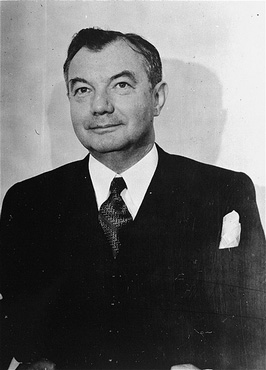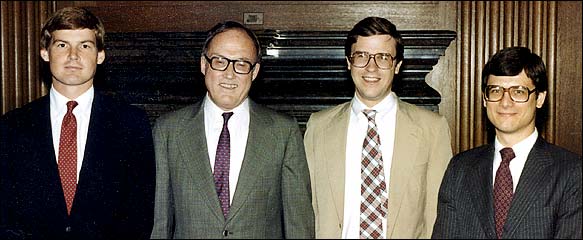Justice Rehnquist wrote Dames & Moore v. Regan in a short span of 8 days. One of the more historically poetic aspects of this opinion was how Rehnquist cites as the definitive statement of executive power Justice Jackson’s concurring opinion Youngstown Sheet & Tube Co. v. Sawyer. (Rehnquist would modify, somewhat, the nature of Jackson’s opinion).
 Of course, Rehnquist clerked for Jackson that term. As Judge Bybee noted in this article:
Of course, Rehnquist clerked for Jackson that term. As Judge Bybee noted in this article:
Rehnquist’s first professional brush with the separation of powers came soon after the start of his legal career as a junior law clerk to Justice Robert Jackson. It was an auspicious start. Rehnquist began his clerkship in February 1952, just months prior to the famous Youngstown separation of powers litigation at the Supreme Court . . . . On May 16, 1952, the Court voted 6-3 in conference to reject Truman’s claim of authority to seize the steel mills.15 As Justice Jackson described the vote to his then-law clerks William Rehnquist and C. George Niebank, Jr., “Well boys, the President got licked.’
Yet, Youngstown was written by Jackson himself, with little involvement by his clerks. In fact Rehnquist and his co-clerks suggested resolving the case on non-separation of powers grounds.
To begin, Jackson’s law clerks had very little hand in drafting his opinions generally and little role in preparing the Youngstown concurrence specifically. 30 Thus, the Youngstown concurrence represented Jackson’s, not Rehnquist’s, work product. In fact, archival materials indicate law clerk Rehnquist suggested alternate non-separation of powers grounds on which Youngstown might have been resolved. In an apparently unsolicited memorandum to Justice Jackson, William Rehnquist and his co-clerk proposed they undertake additional research for Youngstown. Interestingly, all the issues proposed non-separation of powers grounds for resolving the appeal–e.g., by balancing equities on the preliminary injunction, etc.31 To be sure, the 1952 clerk memorandum, standing by itself, would be a thin reed to support a claim that Rehnquist had doubts about resolving the separation of powers question in Youngstown against the President. It might merely suggest Rehnquist favored the parsimonious adjudication of constitutional cases by resort to avoidance. The memorandum, however, does not stand by itself. In his book The Supreme Court, Rehnquist, without mentioning his prior memorandum, expressed doubts about how Youngstown was resolved. Noting that the separation of powers issue was not well settled, but in his view “more or less up for grabs,” he believed Youngstown might have been resolved on the balancing of equities and that the law on those issues favored the executive.32
And guess who was clerking for Justice Rehnquist in 1981 when Dames & Moore was decided.
A young pup names John G. Roberts (first from the right), who would go on to replace his boss as the Chief Justice of the United States.
On the last day of the term in 1981, for instance, Justice Rehnquist wrote for a unanimous court to say that Presidents Carter and Reagan had the legal authority to nullify court orders and suspend private lawsuits as part of the agreement with Iran that ended the hostage crisis there. The decision, Dames & Moore v. Regan, took an exceptionally deferential view of executive power.
Judge Roberts cited the decision last year in an opinion accepting the Bush administration’s position that it could block claims against Iraq from American soldiers who had been tortured there during the Persian Gulf war.
A fascinating legacy for separation of powers.
